what unusual property of carbon makes it so important to living things
The Chemical Foundation of Life
7 Carbon
Learning Objectives
By the terminate of this department, you volition be able to do the following:
- Explicate why carbon is important for life
- Describe the office of functional groups in biological molecules
Many circuitous molecules called macromolecules, such equally proteins, nucleic acids (RNA and Dna), carbohydrates, and lipids incorporate cells. The macromolecules are a subset of organic molecules (whatsoever carbon-containing liquid, solid, or gas) that are especially of import for life. The fundamental component for all of these macromolecules is carbon. The carbon atom has unique backdrop that allow it to form covalent bonds to every bit many equally four different atoms, making this versatile element ideal to serve as the bones structural component, or "backbone," of the macromolecules.
Individual carbon atoms have an incomplete outermost electron shell. With an diminutive number of half dozen (six electrons and six protons), the first ii electrons make full the inner trounce, leaving four in the 2nd shell. Therefore, carbon atoms can class up to iv covalent bonds with other atoms to satisfy the octet rule. The marsh gas molecule provides an case: information technology has the chemic formula CH4. Each of its four hydrogen atoms forms a single covalent bail with the carbon atom by sharing a pair of electrons. This results in a filled outermost shell.
Hydrocarbons
Hydrocarbons are organic molecules consisting entirely of carbon and hydrogen, such as methyl hydride (CH4) described above. Nosotros often employ hydrocarbons in our daily lives as fuels—like the propane in a gas grill or the butane in a lighter. The many covalent bonds between the atoms in hydrocarbons store a peachy amount of free energy, which releases when these molecules burn (oxidize). Marsh gas, an fantabulous fuel, is the simplest hydrocarbon molecule, with a key carbon atom bonded to 4 different hydrogen atoms, as (Figure) illustrates. The shape of its electron orbitals determines the shape of the methane molecule's geometry, where the atoms reside in three dimensions. The carbons and the iv hydrogen atoms form a tetrahedron, with four triangular faces. For this reason, nosotros draw methane as having tetrahedral geometry.
Methane has a tetrahedral geometry, with each of the iv hydrogen atoms spaced 109.5° apart.
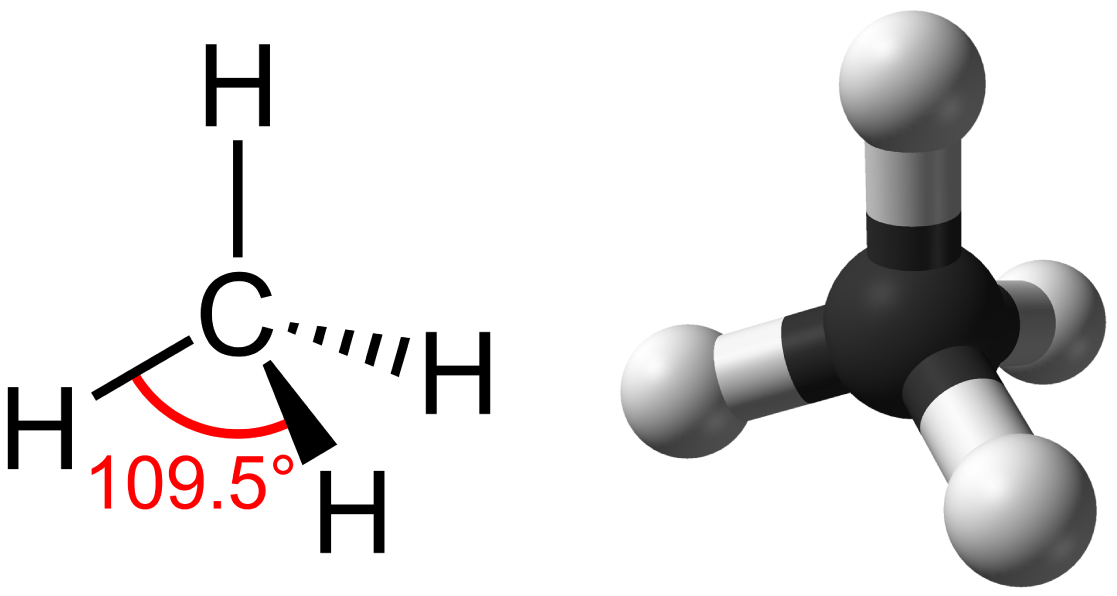
As the backbone of the large molecules of living things, hydrocarbons may exist as linear carbon chains, carbon rings, or combinations of both. Furthermore, individual carbon-to-carbon bonds may be unmarried, double, or triple covalent bonds, and each blazon of bond affects the molecule's geometry in a specific way. This three-dimensional shape or conformation of the large molecules of life (macromolecules) is disquisitional to how they function.
Hydrocarbon Chains
Successive bonds betwixt carbon atoms class hydrocarbon chains. These may be branched or unbranched. Furthermore, a molecule's different geometries of single, double, and triple covalent bonds modify the overall molecule's geometry equally (Figure) illustrates. The hydrocarbons ethane, ethene, and ethyne serve as examples of how different carbon-to-carbon bonds impact the molecule's geometry. The names of all 3 molecules start with the prefix "eth-," which is the prefix for two carbon hydrocarbons. The suffixes "-i," "-ene," and "-yne" refer to the presence of single, double, or triple carbon-carbon bonds, respectively. Thus, propane, propene, and propyne follow the same pattern with three carbon molecules, butane, butene, and butyne for 4 carbon molecules, then on. Double and triple bonds change the molecule'southward geometry: unmarried bonds permit rotation along the bail's axis; whereas, double bonds lead to a planar configuration and triple bonds to a linear i. These geometries have a pregnant impact on the shape a particular molecule can assume.
When carbon forms single bonds with other atoms, the shape is tetrahedral. When two carbon atoms course a double bond, the shape is planar, or flat. Single bonds, like those in ethane, are able to rotate. Double bonds, like those in ethene cannot rotate, so the atoms on either side are locked in place.

Hydrocarbon Rings
So far, the hydrocarbons we take discussed take been aliphatic hydrocarbons, which consist of linear chains of carbon atoms. Another type of hydrocarbon, aromatic hydrocarbons, consists of airtight rings of carbon atoms. We discover ring structures in hydrocarbons, sometimes with the presence of double bonds, which we can see by comparing cyclohexane's structure to benzene in (Figure). Examples of biological molecules that contain the benzene band include some amino acids and cholesterol and its derivatives, including the hormones estrogen and testosterone. We besides find the benzene ring in the herbicide 2,four-D. Benzene is a natural component of crude oil and has been classified every bit a carcinogen. Some hydrocarbons have both aliphatic and aromatic portions. Beta-carotene is an instance of such a hydrocarbon.
Carbon tin course 5- and 6-membered rings. Unmarried or double bonds may connect the carbons in the ring, and nitrogen may exist substituted for carbon.

Isomers
The 3-dimensional placement of atoms and chemical bonds within organic molecules is central to understanding their chemistry. Nosotros telephone call molecules that share the aforementioned chemical formula but differ in the placement (structure) of their atoms and/or chemical bonds isomers. Structural isomers (like butane and isobutene in (Figure)a) differ in the placement of their covalent bonds: both molecules have 4 carbons and ten hydrogens (CfourH10), only the different cantlet system within the molecules leads to differences in their chemic backdrop. For instance, butane is suited for employ as a fuel for cigarette lighters and torches; whereas, isobutene is suited for apply as a refrigerant and a propellant in spray cans.
Geometric isomers, alternatively have similar placements of their covalent bonds but differ in how these bonds are made to the surrounding atoms, especially in carbon-to-carbon double bonds. In the elementary molecule butene (C4Height), the 2 methyl groups (CH3) can exist on either side of the double covalent bond primal to the molecule, every bit (Effigy)b illustrates. When the carbons are spring on the same side of the double bond, this is the cis configuration. If they are on opposite sides of the double bail, it is a trans configuration. In the trans configuration, the carbons grade a more or less linear construction; whereas, the carbons in the cis configuration make a bend (change in direction) of the carbon backbone.
Visual Connection
We call molecules that have the same number and blazon of atoms arranged differently isomers. (a) Structural isomers have a dissimilar covalent organisation of atoms. (b) Geometric isomers accept a different arrangement of atoms around a double bond. (c) Enantiomers are mirror images of each other.
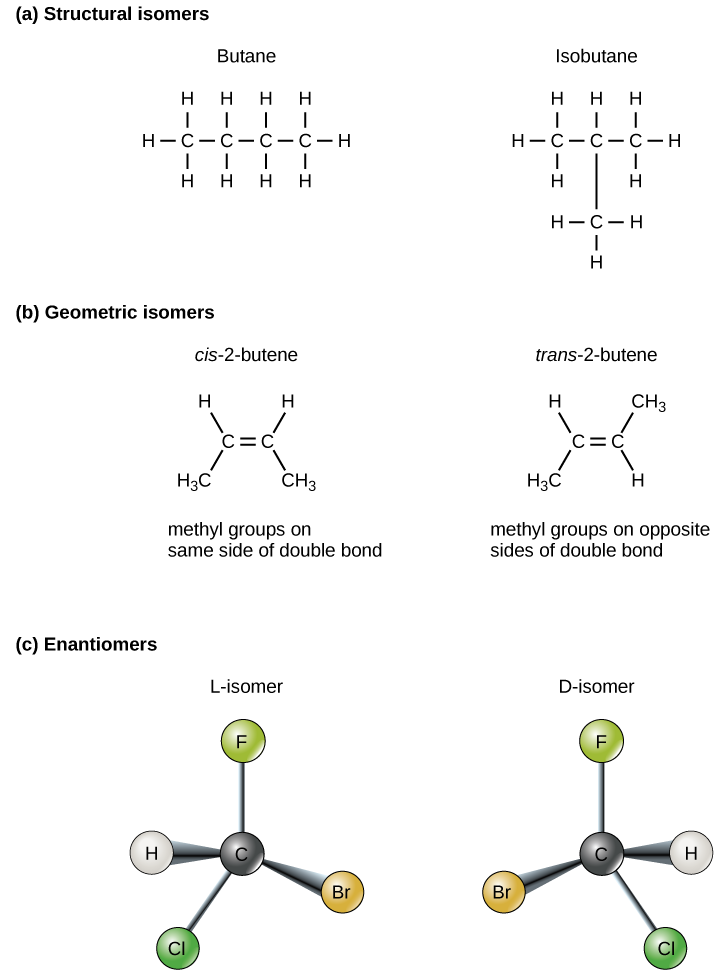
Which of the following statements is faux?
- Molecules with the formulas CHiiiCH2COOH and C3H6O2 could be structural isomers.
- Molecules must have a double bail to be cis–trans isomers.
- To be enantiomers, a molecule must have at to the lowest degree three dissimilar atoms or groups connected to a central carbon.
- To be enantiomers, a molecule must have at to the lowest degree four unlike atoms or groups connected to a central carbon.
<!–<para>C–>
In triglycerides (fats and oils), long carbon bondage known as fatty acids may incorporate double bonds, which tin be in either the cis or trans configuration, equally (Figure) illustrates. Fats with at least one double bond between carbon atoms are unsaturated fats. When some of these bonds are in the cis configuration, the resulting bend in the chain's carbon backbone ways that triglyceride molecules cannot pack tightly, so they remain liquid (oil) at room temperature. Alternatively, triglycerides with trans double bonds (popularly chosen trans fats), take relatively linear fatty acids that are able to pack tightly together at room temperature and form solid fats. In the human diet, trans fats are linked to an increased hazard of cardiovascular disease, so many food manufacturers have reduced or eliminated their apply in recent years. In contrast to unsaturated fats, we telephone call triglycerides without double bonds between carbon atoms saturated fats, meaning that they contain all the hydrogen atoms bachelor. Saturated fats are a solid at room temperature and ordinarily of animal origin.
These space-filling models bear witness a cis (oleic acid) and a trans (eliadic acrid) fatty acid. Notice the curve in the molecule acquired by the cis configuration.
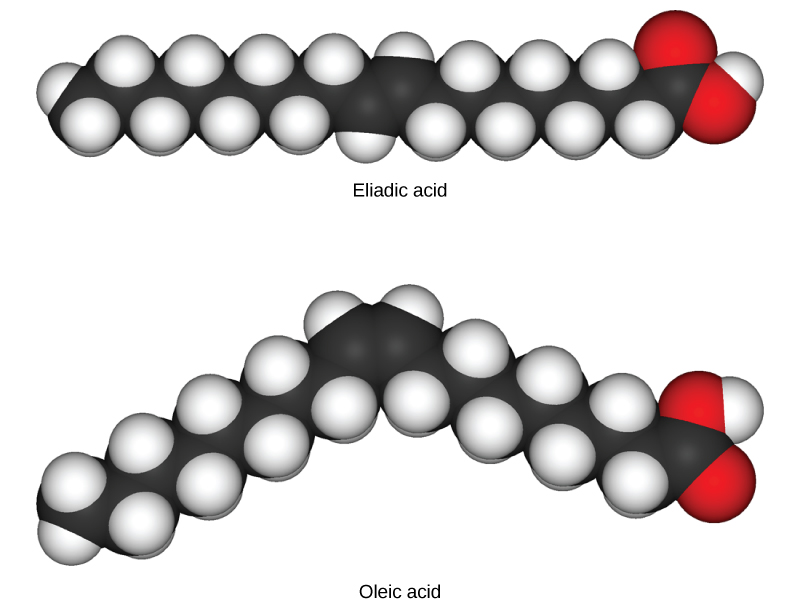
Enantiomers
Enantiomers are molecules that share the same chemical structure and chemical bonds but differ in the 3-dimensional placement of atoms and so that they are non-superimposable mirror images. (Effigy) shows an amino acid alanine instance, where the two structures are nonsuperimposable. In nature, only the Fifty-forms of amino acids make proteins. Some D forms of amino acids are seen in the prison cell walls of leaner, but never in their proteins. Similarly, the D-form of glucose is the main product of photosynthesis and nosotros rarely see the molecule'southward L-grade in nature.
D-alanine and L-alanine are examples of enantiomers or mirror images. Only the L-forms of amino acids are used to make proteins.
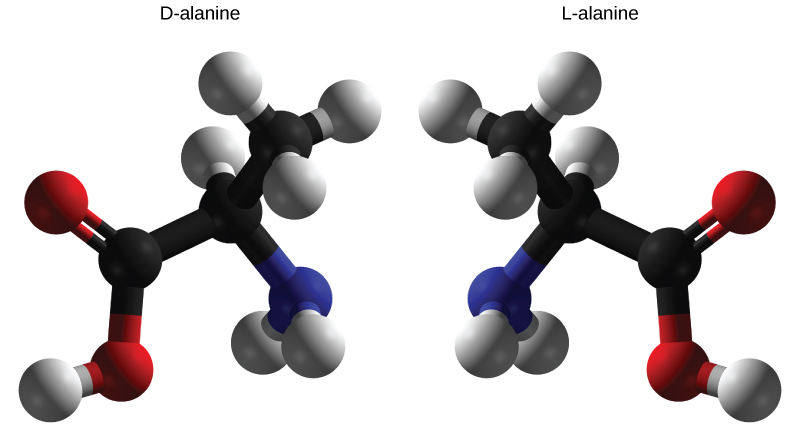
Functional Groups
Functional groups are groups of atoms that occur within molecules and confer specific chemical properties to those molecules. We find them forth the "carbon courage" of macromolecules. Bondage and/or rings of carbon atoms with the occasional substitution of an element such as nitrogen or oxygen grade this carbon backbone. Molecules with other elements in their carbon courage are substituted hydrocarbons.
The functional groups in a macromolecule are usually attached to the carbon backbone at i or several different places along its chain and/or band construction. Each of the four types of macromolecules—proteins, lipids, carbohydrates, and nucleic acids—has its own characteristic gear up of functional groups that contributes profoundly to its differing chemical backdrop and its office in living organisms.
A functional group can participate in specific chemical reactions. (Effigy) shows some of the important functional groups in biological molecules. They include: hydroxyl, methyl, carbonyl, carboxyl, amino, phosphate, and sulfhydryl. These groups play an of import part in forming molecules like DNA, proteins, carbohydrates, and lipids. We usually classify functional groups as hydrophobic or hydrophilic depending on their charge or polarity characteristics. An example of a hydrophobic group is the nonpolar methyl molecule. Among the hydrophilic functional groups is the carboxyl group in amino acids, some amino acid side bondage, and the fatty acids that form triglycerides and phospholipids. This carboxyl group ionizes to release hydrogen ions (H+) from the COOH group resulting in the negatively charged COO– group. This contributes to the hydrophilic nature of whatever molecule on which it is institute. Other functional groups, such as the carbonyl group, take a partially negatively charged oxygen atom that may grade hydrogen bonds with water molecules, once more making the molecule more hydrophilic.
These functional groups are in many different biological molecules. R, likewise known every bit R-grouping, is an abbreviation for any group in which a carbon or hydrogen atom is attached to the rest of the molecule.
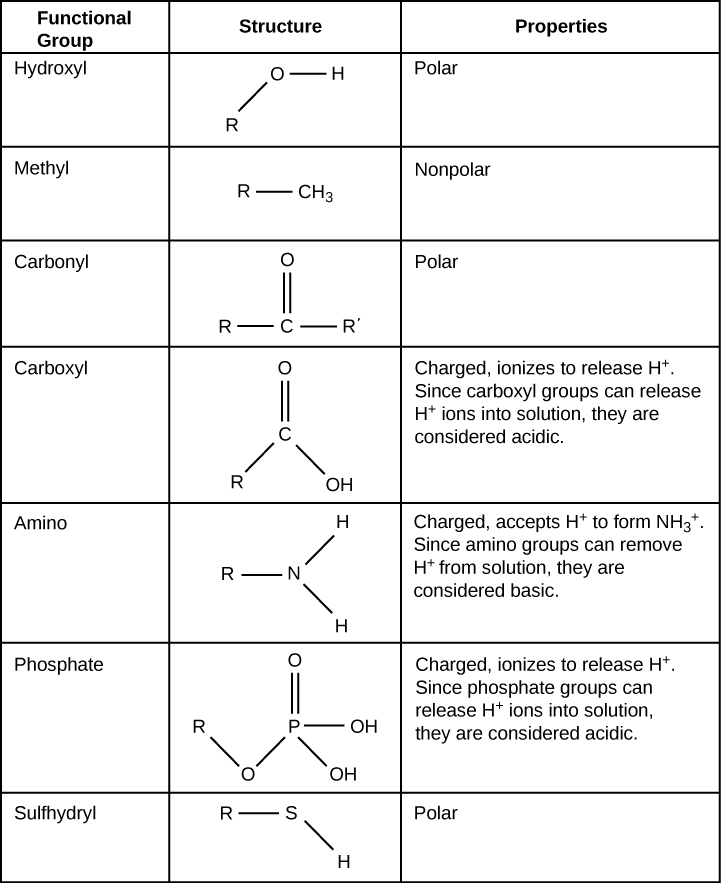
Hydrogen bonds between functional groups (within the same molecule or betwixt different molecules) are important to the function of many macromolecules and help them to fold properly into and maintain the advisable shape for functioning. Hydrogen bonds are also involved in various recognition processes, such as Dna complementary base pairing and the binding of an enzyme to its substrate, every bit (Figure) illustrates.
Hydrogen bonds connect 2 strands of Deoxyribonucleic acid together to create the double-helix structure.
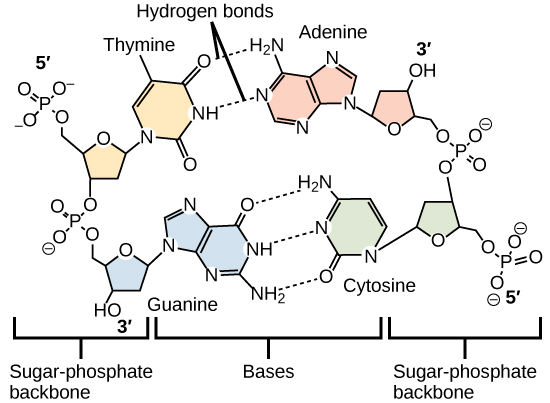
Department Summary
The unique properties of carbon make it a fundamental part of biological molecules. Carbon binds to oxygen, hydrogen, and nitrogen covalently to form the many molecules of import for cellular function. Carbon has four electrons in its outermost shell and can form iv bonds. Carbon and hydrogen can form hydrocarbon chains or rings. Functional groups are groups of atoms that confer specific backdrop to hydrocarbon (or substituted hydrocarbon) chains or rings that ascertain their overall chemical characteristics and part.
Visual Connection Questions
(Figure) Which of the following statements is fake?
- Molecules with the formulas CH3CHiiCOOH and C3Hhalf-dozenO2 could exist structural isomers.
- Molecules must have a double bond to be cis–trans isomers.
- To be enantiomers, a molecule must have at least three different atoms or groups continued to a central carbon.
- To be enantiomers, a molecule must take at least four different atoms or groups connected to a key carbon.
(Figure) C
Review Questions
Each carbon molecule can bail with as many as________ other atom(southward) or molecule(s).
- one
- two
- six
- four
D
Which of the following is not a functional grouping that tin can bond with carbon?
- sodium
- hydroxyl
- phosphate
- carbonyl
A
Critical Thinking Questions
What property of carbon makes it essential for organic life?
Carbon is unique and establish in all living things because it can form upward to four covalent bonds betwixt atoms or molecules. These tin can exist nonpolar or polar covalent bonds, and they allow for the formation of long chains of carbon molecules that combine to grade proteins and Deoxyribonucleic acid.
Compare and contrast saturated and unsaturated triglycerides.
Saturated triglycerides contain no double bonds betwixt carbon atoms; they are usually solid at room temperature. Unsaturated triglycerides contain at least one double bond between carbon atoms and are usually liquid at room temperature.
Glossary
- aliphatic hydrocarbon
- hydrocarbon consisting of a linear chain of carbon atoms
- aromatic hydrocarbon
- hydrocarbon consisting of closed rings of carbon atoms
- enantiomers
- molecules that share overall structure and bonding patterns, but differ in how the atoms are iii dimensionally placed such that they are mirror images of each other
- functional group
- grouping of atoms that provides or imparts a specific function to a carbon skeleton
- geometric isomer
- isomer with like bonding patterns differing in the placement of atoms aslope a double covalent bond
- hydrocarbon
- molecule that consists but of carbon and hydrogen
- isomers
- molecules that differ from ane another fifty-fifty though they share the same chemical formula
- organic molecule
- any molecule containing carbon (except carbon dioxide)
- structural isomers
- molecules that share a chemical formula just differ in the placement of their chemical bonds
- substituted hydrocarbon
- hydrocarbon concatenation or ring containing an atom of another element in place of one of the courage carbons
Source: https://opentextbc.ca/biology2eopenstax/chapter/carbon/
0 Response to "what unusual property of carbon makes it so important to living things"
Post a Comment